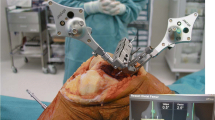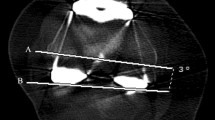Abstract
Introduction
The most commonly used tool for implant positioning are conventional instruments (CI) followed by computer-assisted surgery (CAS). A number of studies have investigated the cutting error of the tibial component when CAS is used, but most of them were focused on the cutting angles. The accuracy of CAS to determine the depth of the cut has not received much attention, even though implications are similar or worse, than with an angle mismatch.
Materials and methods
This was an ethics board approved, prospective study of 23 consecutive varus TKAs by a single surgeon. Implant positioning was performed using CAS; however, the depth of the tibial cut was determined with both CAS and CI. Targeted alignment was the mechanical axis and 3° of posterior slope. The planned and the achieved cut, as determined by CAS needed to match. The achieved cut was then measured using a caliper and compared to the depth of the cut as per CAS. Medial and lateral cuts were analyzed separately. Analysis of variance and Bland–Altman plots were used for the comparison.
Results
Mean medial navigated cut was 6.3 (± 2.2) mm, mean measured medial cut was 6.6 (± 2.3) mm. Mean lateral navigated cut was 8.9 (± 1.8) mm, mean measured lateral cut was 8.8 (± 1.5) mm. There was a statistical significance for both the medial (p < 0.001) and the lateral (p = 0.004) navigated and measured cuts.
Conclusions
The results of this study suggest that the tibial cut depth, measured by the navigation, does not match the actual bony cuts performed, even if a perfect cut was achieved in both sagittal and coronal plane. Surgeons should be aware of the measurement error in the navigation system and potentially add an additional step for verifying the achieved depth of the cut.








Similar content being viewed by others
References
Beal MD, Delagramaticas D, Fitz D (2016) Improving outcomes in total knee arthroplasty—do navigation or customized implants have a role? J Orthop Surg Res. https://doi.org/10.1186/s13018-016-0396-8
National Joint Replacement Registry AOA (2019) 2019 Hip, Knee and Shoulder Arthroplasty Annual Report
Wernecke GC, Taylor S, Wernecke P et al (2017) Resection accuracy of patient-specific cutting guides in total knee replacement. ANZ J Surg 87:921–924. https://doi.org/10.1111/ans.14143
Scholes C, Sahni V, Lustig S et al (2014) Patient-specific instrumentation for total knee arthroplasty does not match the pre-operative plan as assessed by intra-operative computer-assisted navigation. Knee Surg Sports Traumatol Arthrosc 22:660–665. https://doi.org/10.1007/s00167-013-2670-1
Lustig S, Scholes CJ, Oussedik SI et al (2013) Unsatisfactory accuracy as determined by computer navigation of VISIONAIRE patient-specific instrumentation for total knee arthroplasty. J Arthroplasty 28:469–473. https://doi.org/10.1016/j.arth.2012.07.012
Zambianchi F, Colombelli A, Digennaro V et al (2017) Assessment of patient-specific instrumentation precision through bone resection measurements. Knee Surg Sports Traumatol Arthrosc 25:2841–2848. https://doi.org/10.1007/s00167-015-3949-1
Schlatterer B, Linares J-M, Chabrand P et al (2014) Influence of the optical system and anatomic points on computer-assisted total knee arthroplasty. Orthop Traumatol Surg Res 100:395–402. https://doi.org/10.1016/j.otsr.2013.12.029
Hasegawa M, Yoshida K, Wakabayashi H, Sudo A (2013) Cutting and implanting errors in minimally invasive total knee arthroplasty using a navigation system. Int Orthop 37:27–30. https://doi.org/10.1007/s00264-012-1688-1
Bugbee WD, Kermanshahi AY, Munro MM et al (2014) Accuracy of a hand-held surgical navigation system for tibial resection in total knee arthroplasty. Knee 21:1225–1228. https://doi.org/10.1016/j.knee.2014.09.006
Tsukeoka T, Tsuneizumi Y, Yoshino K (2019) An accelerometer-based navigation did not improve the femoral component positioning compared to a modified conventional technique of pre-operatively planned placement of intramedullary rod in total knee arthroplasty. Arch Orthop Trauma Surg 139:561–567. https://doi.org/10.1007/s00402-019-03147-1
Tsukeoka T, Tsuneizumi Y, Yoshino K, Suzuki M (2018) Case-related factors affecting cutting errors of the proximal tibia in total knee arthroplasty assessed by computer navigation. Knee Surg Sports Traumatol Arthrosc 26:1493–1499. https://doi.org/10.1007/s00167-016-4397-2
Wernecke GC, Harrris IA, Seeto BG et al (2016) Normal femorotibial rotational alignment and implications for total knee arthroplasty: an MRI analysis. HSS J 12:216–222. https://doi.org/10.1007/s11420-016-9491-y
Zimmer® NexGen® CR-Flex Surgical Technique. https://www.zimmer.com/content/dam/zimmer-web/documents/en-US/pdf/surgical-techniques/knee/zimmer-nexgen-cr-flex-lps-flex-knee-surgical-technique-posterior-referencing-instrumentation-surgical-technique.pdf. Accessed 15 Feb 2020
Howell SM (2019) Calipered kinematically aligned total knee arthroplasty: an accurate technique that improves patient outcomes and implant survival. Orthopedics 42:126–135. https://doi.org/10.3928/01477447-20190424-02
Berend ME, Ritter MA, Meding JB et al (2004) Tibial component failure mechanisms in total knee arthroplasty. Clin Orthop Relat Res. https://doi.org/10.1097/01.blo.0000148578.22729.0e
Mitsuhashi S, Akamatsu Y, Kobayashi H et al (2018) Combined CT-based and image-free navigation systems in TKA reduces postoperative outliers of rotational alignment of the tibial component. Arch Orthop Trauma Surg 138:259–266. https://doi.org/10.1007/s00402-017-2837-1
Burnett RSJ, Barrack RL (2013) Computer-assisted total knee arthroplasty is currently of no proven clinical benefit: a systematic review. Clin Orthop Relat Res 471:264–276. https://doi.org/10.1007/s11999-012-2528-8
Panjwani TR, Mullaji A, Doshi K, Thakur H (2019) Comparison of functional outcomes of computer-assisted vs conventional total knee arthroplasty: a systematic review and meta-analysis of high-quality, prospective studies. J Arthroplasty 34:586–593. https://doi.org/10.1016/j.arth.2018.11.028
Rice DA, Kluger MT, McNair PJ et al (2018) Persistent postoperative pain after total knee arthroplasty: a prospective cohort study of potential risk factors. Br J Anaesth 121:804–812. https://doi.org/10.1016/j.bja.2018.05.070
Bierke S, Petersen W (2017) Influence of anxiety and pain catastrophizing on the course of pain within the first year after uncomplicated total knee replacement: a prospective study. Arch Orthop Trauma Surg 137:1735–1742. https://doi.org/10.1007/s00402-017-2797-5
Dunbar MJ, Richardson G, Robertsson O (2013) I can’t get no satisfaction after my total knee replacement: rhymes and reasons. Bone Joint J 95-B:148–152. https://doi.org/10.1302/0301-620X.95B11.32767
Clement ND, Walker LC, Bardgett M et al (2018) Patient age of less than 55 years is not an independent predictor of functional improvement or satisfaction after total knee arthroplasty. Arch Orthop Trauma Surg 138:1755–1763. https://doi.org/10.1007/s00402-018-3041-7
Sheth NP, Bonadio MB, Demange MK (2017) Bone loss in revision total knee arthroplasty: evaluation and management. J Am Acad Orthop Surg 25:348–357. https://doi.org/10.5435/JAAOS-D-15-00660
Kamath AF, Lewallen DG, Hanssen AD (2015) Porous tantalum metaphyseal cones for severe tibial bone loss in revision knee arthroplasty: a five to nine-year follow-up. J Bone Joint Surg Am 97:216–223. https://doi.org/10.2106/JBJS.N.00540
Loh B, Chen JY, Yew AKS et al (2017) The accuracy of a hand-held navigation system in total knee arthroplasty. Arch Orthop Trauma Surg 137:381–386. https://doi.org/10.1007/s00402-016-2612-8
Singh AK, Nedopil AJ, Howell SM, Hull ML (2018) Does alignment of the limb and tibial width determine relative narrowing between compartments when planning mechanically aligned TKA? Arch Orthop Trauma Surg 138:91–97. https://doi.org/10.1007/s00402-017-2824-6
Yamamura K, Minoda Y, Mizokawa S et al (2017) Novel alignment measurement technique for total knee arthroplasty using patient specific instrumentation. Arch Orthop Trauma Surg 137:401–407. https://doi.org/10.1007/s00402-017-2628-8
Kwon OR, Kang KT, Son J et al (2017) Patient-specific instrumentation development in TKA: 1st and 2nd generation designs in comparison with conventional instrumentation. Arch Orthop Trauma Surg 137:111–118. https://doi.org/10.1007/s00402-016-2618-2
Stryker® OrthoMap® Precision Knee Product Guide. https://www.strykermeded.com/media/2007/navigation-orthomap-precision-knee-surgical-technique.pdf. Accessed 15 Feb 2020
Yau WP, Chiu KY (2008) Cutting errors in total knee replacement: assessment by computer assisted surgery. Knee Surg Sports Traumatol Arthrosc 16:670–673. https://doi.org/10.1007/s00167-008-0550-x
Ulivi M, Orlandini LC, Meroni V et al (2019) Intraoperative validation of bone cut accuracy of a pinless smart touch-screen navigation system device in total knee arthroplasty. Int J Med Robot. https://doi.org/10.1002/rcs.2030
Thienpont E, Schwab PE, Cornu O et al (2017) Bone morphotypes of the varus and valgus knee. Arch Orthop Trauma Surg 137:393–400. https://doi.org/10.1007/s00402-017-2626-x
Author information
Authors and Affiliations
Corresponding author
Ethics declarations
Conflict of interest
The authors declare that they have no conflicts of interest.
Additional information
Publisher's Note
Springer Nature remains neutral with regard to jurisdictional claims in published maps and institutional affiliations.
Rights and permissions
About this article
Cite this article
Klasan, A., Putnis, S.E., Grasso, S. et al. Conventional instruments are more accurate for measuring the depth of the tibial cut than computer-assisted surgery in total knee arthroplasty: a prospective study. Arch Orthop Trauma Surg 140, 801–806 (2020). https://doi.org/10.1007/s00402-020-03403-9
Received:
Published:
Issue Date:
DOI: https://doi.org/10.1007/s00402-020-03403-9




